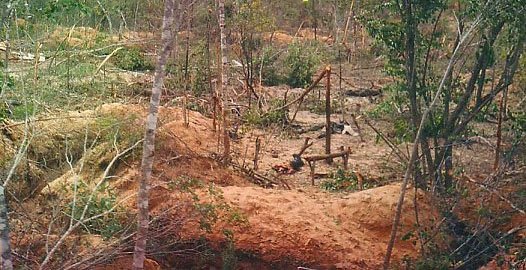The South African Border War - Operation Seiljag
Operation Seiljag was aimed at preventing further PLAN infiltration into South West Africa through preemptive strikes.
In order to do this 32 Battalion operated from November 1976 to March 1977 largely in the Yati Strip.
The yati strip was a 1km wide strip just inside South West Africa.
The operation was led up to by a number of encounters or "contacts" in the strip with insurgents.
These typically did not end well for the insurgents.
It was then that 32 battalion switched from simple patrols to sweeping for forward operating bases.
These bases often consisted of trench networks hidden in the bush.



It became clear during these operations that small groups of PLAN insurgents were not really intent on a fight and would withdraw over the border or further into Angola, even quite quickly retreating from well defended positions.
In the process three forward operating bases were destroyed.
Plan also began hugging the MPLA and Cuban bases more closely in the hopes that the South African would be less likely to engage them so close to the Angolan military presence.
According to Wikipedia
By the end of 1977 it was clear that the South African government would have to take stronger action to curb guerrilla activity. On October 25, 1977, SADF spokesman Wally Black disclosed that there were 300 PLAN militants in the operational area and skirmishes with security forces averaged a hundred a month. A further 2,000 PLAN were active in Angola and 1,400 in Zambia near the Caprivi Strip. Not long after Black's statements an exceptionally large PLAN force of over 80 guerrillas was able to infiltrate the border. The SADF was concerned that such raids could be indicative of a PLAN strategy to increase its semi-conventional capabilities and operate in larger cadres. For over a decade South Africa had concentrated on a counter-insurgency doctrine based on fighting small, lightly armed, and relatively disorganised partisans. PLAN's decision to escalate the war had forced a change in priorities; comparatively punitive actions such as Operation Seiljag were no longer regarded as adequate.
This would lead to Operation Reindeer and the so called "Casinga massacre" and the political disaster it would become.
Previous posts in this series can be found at the bottom of this post:
The South African Border War - 1976, The end of a chapter and the beginning of a new phase.
The South African Border War - Mines, Mines did I say mines?


Hey @gavvet, i see you quite into the military stuff. I found some photos i took at an airshow at Swartkops Airforce Base. If you interested and have time have a look.
https://steemit.com/planes/@byronviljoen/swartkops-airshow
Great post. I've work for 10 years in the military industry with various of the veterans that fought in the Border War. There are various interesting stories you here when you 'braai' with them. As far as I understand Seiljag was one of the earlier operations.
What was the role of the Recces during this operation? As far as I know they were instrumental to elimination of enemy front-line forces. Please do a write-up on some of the Recce operations! ;)
The South African Reconnaissance Commando was quite newly formed in 1977, their main objective in the case of Seiljag would have been information gathering, I do not think they were involved in Seiljag as at this stage the unit was quite small and mainly on missions in Zimbabwe ( then Rhodesia), the official unit only came into existence in 1970 with Commandant Breytenbach hand picking 11 men to join him, previously the operations were carried out under the Hunter Group and only formally recognized as a unit in 1972.
I am also interested to hear more about the Recces.
Recces were everywhere and nowhere all the time.
What do you mean?
they operated in small groups and were pretty much active all the time, wherever necessary, but nobody would generally know about it.
I see what you mean. Did they actually do anything useful though?
They where super useful and in some cases a single Recce took out a full enemy base. They are known for "Guerrilla warfare" and trust me, there are the most hard-core people I have met in my life!
What do you mean by hard core? Yeah makes sense! 😀 😃 😄
they would get there..."the firstest, the fastest, with the mostest"
Hi, I'm Venezuelan, I like your post. Can you give me your vote in my post? @gavvet
I think you are a great article writer, and very useful to everyone,
will you help me introduce myself @gavvet
A always great post
The true power of guerilla warfare isn't military but political. It is almost perfectly optimized for getting the bigger stronger side to defeat itself either by appearing hapless or, as ended transpiring in the above case, disastrously overreacting in a bid to *
now to onward, started to follow you.
@gavvet talking about war is really sad
I already feel how the state of war
awry,,
the atmosphere is always in a tense state.
let alone anti-guerrilla warfare
I do not think you have felt the tragedy of war
thanks for sharing
Fell very worst :(
The next clash of the last century, if we talk about the war as a whole, then immediately it is necessary to discard the opposition of white and black. The opposition was against the spread of the ideas of Marxism and black nationalism in Southern Africa.